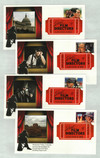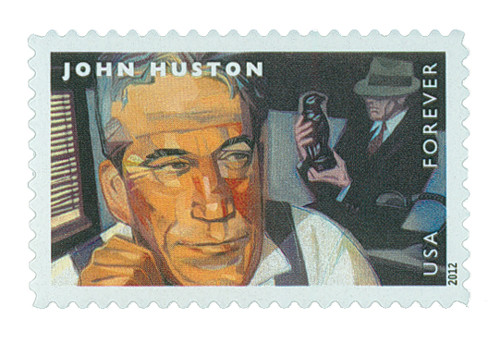
2012 First-Class Forever Stamp,Great Film Directors
# 4668-71 - 2012 First-Class Forever Stamp - Great Film Directors
$6.50 - $67.50
U.S. #4668-71
2012 45¢ Great Film Directors
Issue Date: May 23, 2012
City: Silver Spring, MD
Quantity: 25,000,000
Printed By: Avery Dennison
Printing Method: Photogravure
Color: multicolored
“The directing of a picture involves coming out of your individual loneliness and taking a controlling part in putting together a small world. A picture is made. You put a frame around it and move on.” – John Huston
The earliest films appeared in the late 19th century. Rarely over a minute long, they were often composed of a single scene and had no editing. By the turn of the century, multiple silent films were displayed in 4,700 nickelodeon cinemas and the movie industry began to grow rapidly.
Technology boomed, and soon multi-reel films emerged, allowing for longer movies. With the industry expanding, the importance of directors grew. The emergence of “talkies” further emphasized the director’s role.
America’s great film directors of the early 20th century are the heart of modern cinema. John Ford’s iconic Stagecoach introduced the world to then-unknown John Wayne, and has since been imitated by countless others. Frank Capra set out to make movies with a positive message – indeed, It’s a Wonderful Life is considered one of the most inspirational movies of all time. Billy Wilder hits such as Double Indemnity pioneered the film noir crime drama style that remains popular today. And John Huston’s films, such as The Asphalt Jungle, brought viewers into a new realm, sympathizing with criminals, an idea often used in modern movies.
Today, the movies of each of these men top countless “Best of” lists and continue to serve as the models of great films for the ages.
U.S. #4668-71
2012 45¢ Great Film Directors
Issue Date: May 23, 2012
City: Silver Spring, MD
Quantity: 25,000,000
Printed By: Avery Dennison
Printing Method: Photogravure
Color: multicolored
“The directing of a picture involves coming out of your individual loneliness and taking a controlling part in putting together a small world. A picture is made. You put a frame around it and move on.” – John Huston
The earliest films appeared in the late 19th century. Rarely over a minute long, they were often composed of a single scene and had no editing. By the turn of the century, multiple silent films were displayed in 4,700 nickelodeon cinemas and the movie industry began to grow rapidly.
Technology boomed, and soon multi-reel films emerged, allowing for longer movies. With the industry expanding, the importance of directors grew. The emergence of “talkies” further emphasized the director’s role.
America’s great film directors of the early 20th century are the heart of modern cinema. John Ford’s iconic Stagecoach introduced the world to then-unknown John Wayne, and has since been imitated by countless others. Frank Capra set out to make movies with a positive message – indeed, It’s a Wonderful Life is considered one of the most inspirational movies of all time. Billy Wilder hits such as Double Indemnity pioneered the film noir crime drama style that remains popular today. And John Huston’s films, such as The Asphalt Jungle, brought viewers into a new realm, sympathizing with criminals, an idea often used in modern movies.
Today, the movies of each of these men top countless “Best of” lists and continue to serve as the models of great films for the ages.














